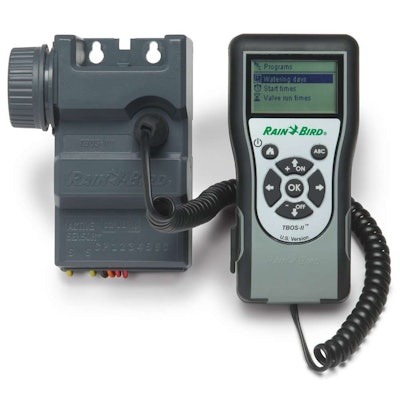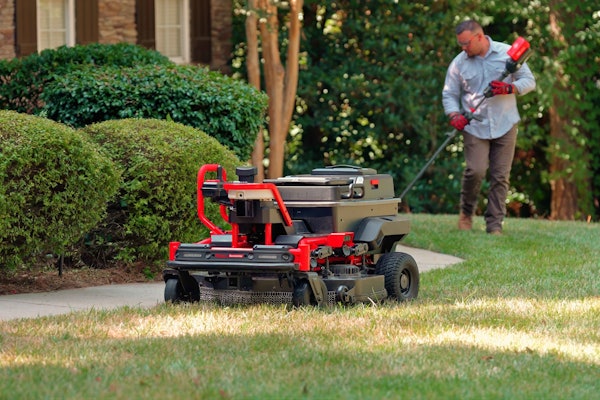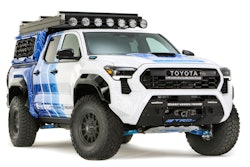
They’re more common than you may think. We see them in operation on sites like street medians, landscaped roadsides and construction sites without easy access to electrical power, as well as within public landscapes where vandalism is a concern. And, for the most part, we don’t give them a second thought. But the truth is that battery-operated controllers have been helping irrigate a broad range of sites for more than 17 years. According to Rengan Rajendran, product manager for Rain Bird commercial controllers, these handy little devices have a history of saving the day for sites that, for one reason or another, are unable to use standard irrigation controllers.
“Battery-operated controllers can provide a much-needed option at sites when there’s no AC power available,” Rajendran says. “They can be used permanently or temporarily depending upon the situation. For example, a landscaper may want to expand an existing site, but there’s no controller wiring to add a new valve. Or, perhaps a site is still under construction, and the electricity hasn’t been hooked up. There are also sites that prefer to use battery-operated controllers because a standard controller could be damaged by vandalism or flooding.”
How they work
Battery-operated controllers generally consist of a controller powered by a battery that must be replaced annually. The controller connects to a potted latching solenoid located inside a valve box. Both the controller and its battery are tightly sealed to prevent problems should water enter the valve box at any time. Users can choose from different controller models based upon the number of zones they need to irrigate. Some controllers have a rudimentary built-in user interface for programming and scheduling, while others feature a hand-held device with more robust programming features. After a controller is programmed, it retains its new schedule and operates the valve accordingly.
While most of today’s battery-operated controllers are based upon the same basic design principles, they’re certainly not all created equal. There are many different brands and models available on the market depending up on a site’s needs. “The battery-operated controllers available today range from simpler contractor-level versions for residential use to commercial-type controllers more appropriate for larger sites like parks or shopping malls,” Rajendran says. “The pricing of the contractor-level battery-operated controllers is similar to comparable AC-powered versions — around $150. Higher-end battery-operated controllers used for commercial sites tend to be on the lower end of the commercial controller price, somewhere in the $200-$300 range. Either way, when you factor in the amount of time and water that you can save by implementing one of these controllers rather than manually managing irrigation, they can pay for themselves pretty quickly.”
Improving irrigation efficiency
Most battery-operated controllers offer the same basic features as comparable standard AC-powered controllers. Users can set days and times to water, which stations to water and how long to water them. Some offer multiple program options so that it’s possible to have one program that waters the grass and another that waters shrubs. They also typically allow users to choose from multiple watering start times. “The benefit of that is that if you’re on a slope or dealing with compacted soil, you can irrigate for maybe ten minutes, stop and then irrigate another ten minutes so you don’t get runoff,” Rajendran explains.
With so much additional focus today on water efficiency and management, manufacturers are also integrating more water-smart features into their battery-operated controllers. For example, Rain Bird’s TBOS-II now offers a monthly seasonal adjust feature that allows users to adjust water schedules by a percentage depending on the watering needs typical to that time of the year. During the hottest months, a user may choose to adjust watering up to 150 or 200 percent of the base schedule or scale down to 40 or 50 percent in cooler, wetter months. “As of now, battery-operated controllers can’t calculate actual ET (evapotranspiration) rates,” Rajendran says. “To do so, a controller would have to constantly receive both real-time and historical weather data, and battery-operated controllers simply don’t have the battery life to do that.”
Saving time is certainly important, as well. New options like the ability to name each zone on the battery-operated controller (e.g. “Front Commons Area,” “Shrubs,” “Sidewalk Strip,” etc.) make adjusting schedules faster and easier. Controllers that offer the ability to create program templates help contractors and irrigation managers create watering schedules that can be easily transferred to new controllers as they’re installed.
The future
With irrigation technology constantly changing and evolving, what’s the outlook for these battery-operated devices? Both domestically and internationally, battery-operated controllers can play a major role in a number of retrofit applications.
“I think the market will increase due to the number of existing systems that need to be updated,” Rajendran says. “There are many countries that deal with inconsistent electrical power, like India. Power goes out there all the time, and it’s a real issue. In a lot of these emerging countries where the power is often down for two or three hours each day, a battery-operated controller offers a better solution. Many sites run into the issue of needing to add an irrigation zone, but they don’t have another zone available on their current controller. Domestically, there’s also a solid need to simplify system expansions and provide more consistent irrigation at remote sites. While they can’t yet use real-time ET data, battery-operated controllers have improved to the point that they can do just about everything else a regular controller can do.”










